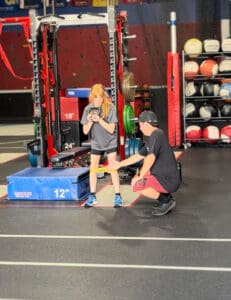
Preventing ACL Injuries in Soccer Players: Training Tips
By: Kyle Ertel
Why ACL injuries matter in soccer
 ACL injuries can be devastating. They affect not only a player’s current season but also their long-term goals. For many athletes, surgery and rehabilitation can take 9 to 12 months, and even then, some return with reduced strength and a higher chance of re-injury.
ACL injuries can be devastating. They affect not only a player’s current season but also their long-term goals. For many athletes, surgery and rehabilitation can take 9 to 12 months, and even then, some return with reduced strength and a higher chance of re-injury.
Female soccer players are especially at risk. Studies show that they suffer ACL tears at a higher rate than male players. Most ACL injuries in soccer are non-contact, meaning they happen without any physical collision. A common mechanism is the “knee collapse” or “knock-knee,” when the knee buckles inward toward the body’s midline.
 ACL injuries can be devastating. They affect not only a player’s current season but also their long-term goals. For many athletes, surgery and rehabilitation can take 9 to 12 months, and even then, some return with reduced strength and a higher chance of re-injury.
ACL injuries can be devastating. They affect not only a player’s current season but also their long-term goals. For many athletes, surgery and rehabilitation can take 9 to 12 months, and even then, some return with reduced strength and a higher chance of re-injury.
Female soccer players are especially at risk. Studies show that they suffer ACL tears at a higher rate than male players. Most ACL injuries in soccer are non-contact, meaning they happen without any physical collision. A common mechanism is the “knee collapse” or “knock-knee,” when the knee buckles inward toward the body’s midline.
The cost of ACL injuries
An ACL tear impacts more than the athlete’s performance. Surgery and rehabilitation costs can reach thousands of dollars, creating a financial burden on families.
Can ACL injuries be prevented?
While it’s impossible to prevent ACL injuries 100%, athletes can take steps to lower the risk. At Champion’s Quest in Los Alamitos, CA, we focus on:
- Teaching proper deceleration technique to reduce stress on the knee.
- Correcting body alignment to prevent knock-knee movement.
- Decreasing landing forces with improved jumping and landing mechanics.
- Following a functional strength program that develops the quadriceps, hamstrings, abductors, glutes, and core muscles.
- Improving balance and body awareness to support safer movement.
The role of training programs
Pre-season preparation combined with in-season maintenance is key. Athletes who train year-round with strength, conditioning, and skill development are better prepared to stay healthy and compete with confidence.
Take the next step
Not making injury prevention a priority can put your athlete at risk of setbacks that impact their game and future. Structured training helps reduce injuries and builds confidence on the field.
Book a free consultation at Champion’s Quest today to start your athlete on the path to safer play and stronger performance.

